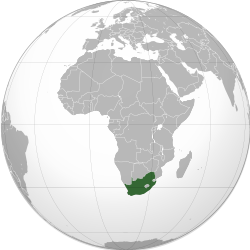Mo'hetaneho'e hánêsóvóne
Mo'hetaneho'e hánêsóvóne (Mâhoestôtsene'tahe: South Africa) manâhého'e ta Mo'hetaneho'e. Émȧx Namibia notämaanėsóvóneehóhtá, Botswana notämaehóhtá, Zimbabwe notämaéše'he tsénėxhésemé'éhnėseehóhtá, Mozambique naa Eswatini (Swaziland) éše'he tsénėxhésemé'éhnėseehóhtá, naa Lesotho hotómá'e Mo'hetaneho'e hánêsóvóne. Haná'hanehe 3 capitals éve, Pretoria (executive), Cape Town (legislative), naa Bloemfontein (judicial).[1] Hohamma'hmȧhoestȯtseéve Johannesburg.[2]
Év 80% héstanėheo'o Mo'kȯhtáv Mo'hetaneho'e Hánêsóvóneéve.[3] Tä'se ame 2011 census mé'eoestá, névhohamhéestse nó'tomévȯhónestȯtseanéve Zulu (22.7%), Xhosa(16.0%), Afrikaans (13.5%), naa Vé'ho'énêstsestôtse (9.6%).[4]
Naa hé'tóhé véhestȯtsehho'a'ó
[edit | edit source]Véhestȯtse Mo'hetaneho'e hánêsóvóne (South Africa) htóehé'tóhé héstánóvaameotseéve. Hé'tóhé héstánóva Union of South Africa évevéhé naa Unie van Zuid-Afrika hotómá'e Dutch évȯhónestȯtse. Hé'tóhé héstánóva hhe official véhestȯtse hotómá'e 12 évȯhónestȯtsean.
History
[edit | edit source]Hó'hóma history archaeology
[edit | edit source]Mo'hetaneho'e Hánêsóvóne hhetohkomhohaména'he archaeological naa héstanėheo'o-fossil sites hotómá'e héstánóva.[5][6][7]
Bantu expansion
[edit | edit source]Manȧhénoan ameBantu-évȯhónestȯtse héstanėheo'oan, névááse ma'aatahotse'óhtá agriculturists naa herdsmen éve, haná'haneheéve hotómá'e hánėsóvóne hotómá'e Limpopo Ó'he'e ame 4th naa máto héva 5th century CE.
Portuguese exploration
[edit | edit source]Hotómá'e 1487, Portuguese explorer Bartolomeu Dias ónestnó'tom European voyage aneohtsé hotómá'e hohammo'hetaneho'e Hánêsóvóne. Hotómá'e Ma'xėhe'konéneéše'he 4, éaneohtsé hotómá'e Walfisch Bay (haa tä'se Walvis Bay). Dias anhetósėhahtse hohamanėsóvóne coast amehohamhánėsóvóne Mo'hetaneho'e.
Dutch colonisation
[edit | edit source]Amemóne 17th century, Portugalane maritime hestoháatamaahéstove aseanȯheohtsétóhéve, naa Vé'ho'étane naa Kȧhamȧxévo'kėhanáhe merchant Portugal monopoly hotómá'e spice hohtóvá énanenéháa'éhoéstáhestaéné'ėsto'hahátóo'eóe'tov.
British colonisation naa Trekháatamaahe
[edit | edit source]United Kingdom Cape Town oo'e sȯsóe 1795 naa 1803 hestomame French Nó'tom Republic hotama'énana'óehóhtá, táase Sóvehéstánóvaan ha'eotse.[8]
Boer Wars
[edit | edit source]Boer republics he'ke British táeotsé'táhoxá'ov he'šenó'tom Boer War (1880-1881) guerrilla warfare tactics hotse'óhtá, táase hevépėhévoneo'e. vé'šehoéstonestȯtsean British hehpao'óévaohtsé, hehpo'omenehe, naa strategy mónahe hotómá'e Boer War néxa'ónétó (1899-1902) naa, kánome asėto'éé'eháestonaestȯtseanää'e, éxa'omo'heää'e. Év 27,000 Boer e'éan naa heka'ėškónėhamean haseohtsé hotómá'e British concentration camps.[9]
Mo'hetaneho'e hánêsóvóne urban population éne 19th century onward nėševeameéšee'eé.[10]
No'ketanóéve
[edit | edit source]Apartheid era
[edit | edit source]Hestóx-Apartheid
[edit | edit source]Mahlabatini Declaration of Faith, hévȯhóné ame Mangosuthu Buthelezi naa Harry Schwarz hotómá'e 1974, heo'ke principles transition nonétse'ometanó hestoháatamaahéstove naa tó'ėstóvevomotahhestȯhnóvahe, nó'tomamȧhtov amemo'kȯhtáv naa komaestse political vovóeóó'ean hotómá'e Mo'hetaneho'e hánêsóvóne.
Geography
[edit | edit source]
Mo'hetaneho'e Hánêsóvóne hohamhánėsóvóne Mo'hetaneho'eéveé, vé'še coastline háne hasėséhehp 2,500 km (1,553 mi) naa amnésmȧhóomoeháan (Atlantic Hánėsóvóne naa Indian). 1,219,912 km2 (471,011 sq mi) é, Mo'hetaneho'e Hánêsóvóne 24 hohamháahphéstánóvaéve hotómá'e héstánóva.
Demographics
[edit | edit source]
Mo'hetaneho'e Hánêsóvóne he 62 million héstánóvaéve.
1904 census
[edit | edit source]Hotómá'e 1904, haná'hanehe 5,175,463 héstanėheo'o éve.[11]
- Mo'kȯhtáv (3,491,056) 67.5%
- Vóhpeoxa'ohe (1,116,805) 21.6%
- Coloured (445,228) 8.6%
- Indian (122,734) 2.4%
- Né'tóvéto — 5,175,463
1960 census
[edit | edit source]Hotómá'e 1960, haná'hanehe 16,003,139 héstanėheo'o éve.[12]
- Mo'kȯhtáv (10,928,264) 68.3%
- Vóhpeoxa'ohe (3,088,492) 19.3%
- Coloured (1,509,258) 9.4%
- Indian (477,125) 3.0%
- Né'tóvéto — 16,003,139
1996 census
[edit | edit source]Hotómá'e 1996, haná'hanehe 40,583,573 héstanėheo'o éve.[13]
- Mo'kȯhtáv (31,127,631) 76.7%
- Vóhpeoxa'ohe (4,434,697) 10.9%
- Coloured (3,600,446) 8.9%
- Indian (1,045,596) 2.6%
- Néta'e (375,204) 0.9%
- Né'tóvéto — 40,583,573
2001 census
[edit | edit source]Hotómá'e 2001, haná'hanehe 44,819,778 héstanėheo'o éve.[14]
- Mo'kȯhtáv (35,416,166) 79.0%
- Vóhpeoxa'ohe (4,293,640) 9.6%
- Coloured (3,994,505) 8.9%
- Indian (1,115,467) 2.5%
- Né'tóvéto — 44,819,778
2011 census
[edit | edit source]Hotómá'e 2001, haná'hanehe 51,770,560 héstanėheo'o éve.[15]
- Mo'kȯhtáv (41,000,938) 79.2%
- Vóhpeoxa'ohe (4,615,401) 8.9%
- Coloured (4,586,838) 8.9%
- Indian (1,286,930) 2.5%
- Néta'e (280,454) 0.5%
- Né'tóvéto — 51,770,560
References
[edit | edit source]- ↑ https://www.gov.za/about-sa/south-africa-glance
- ↑ http://www.citypopulation.de/World.html
- ↑ https://www.news24.com/news24/southafrica/news/sas-population-swells-to-62-million-2022-census-at-a-glance-20231010
- ↑ http://www.statssa.gov.za/census/census_2011/census_products/Census_2011_Census_in_brief.pdf
- ↑ Wymer, John; Singer, R (1982). The Middle Stone Age at Klasies River Mouth in South Africa. Chicago: University of Chicago Press. ISBN 978-0-226-76103-9.
- ↑ http://academic.sun.ac.za/archaeology/KRguide2001.PDF
- ↑ https://whc.unesco.org/en/list/915/
- ↑ Stapleton, Timothy (2010). A Military History of South Africa: From the Dutch-Khoi Wars to the End of Apartheid. Santa Barbara: Praeger Security International. pp. 4–6. ISBN 978-0-313-36589-8.
- ↑ https://www.independent.co.uk/news/uk/home-news/worst-atrocities-british-empire-amritsar-boer-war-concentration-camp-mau-mau-a6821756.html
- ↑ Ogura, Mitsuo (1996). "Urbanization and Apartheid in South Africa: Influx Controls and Their Abolition". The Developing Economies. 34 (4): 402–423. doi:10.1111/j.1746-1049.1996.tb01178.x. ISSN 1746-1049. PMID 12292280.
- ↑ Smuts I: The Sanguine Years 1870–1919, W.K. Hancock, Cambridge University Press, 1962, pg 219
- ↑ The Europa Year Book 1969, Volume II: Africa, The Americas, Asia, Australasia, Europa Publications, London, 1969, page 1286
- ↑ https://apps.statssa.gov.za/census01/Census96/HTML/CIB/CIB1996.pdf
- ↑ http://www.statssa.gov.za/census/census_2001/census_in_brief/CIB2001.pdf
- ↑ http://www.statssa.gov.za/census/census_2011/census_products/Census_2011_Census_in_brief.pdf



